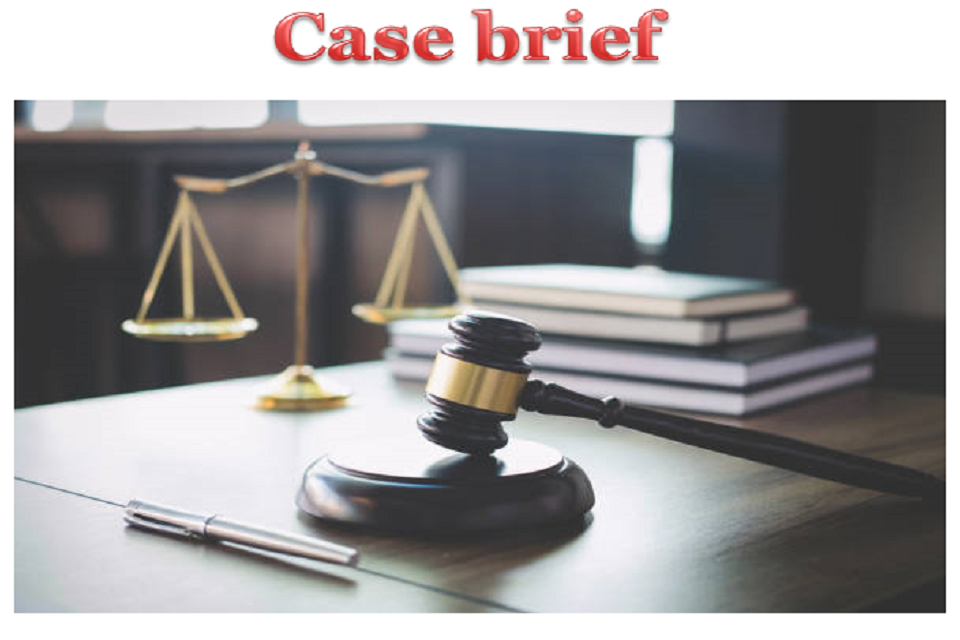Brief guide on how to brief a case for law school

Question:Explain the structure of a case brief. Share a guide on how to brief a case for law school. What are the principles that can assist in making a good case brief for law school?
Pursuing a law degree requires prowess in the art of briefing cases.Being a law student, you will often get tasks related to briefing case laws. In such a situation, students who do not know about it can have several questions related to it, one of them beinghow to brief a case for law school.Primarily, a case brief implies making notesthat help to focus on vital facets of an assigned case.It can be deemed a study aid, allowing you to examine and summarize the broad material you need to understand and recollect.To answer how to brief a case for law school, you need to read, reread, deconstruct and reconstruct the case.A well-constructed case briefing structure is a valuable self-instruction method and an easy-to-use point of reference for your law school discussions.
In this blog on how to brief a case for law school, we will inform you about some techniques that can be effectively used while briefing about case law. With these techniques, you can not only teach others how to brief a case for law school, but you can also actively participate in random class discussions and pave the way for a brighter future.
Structure of case brief
What will be the structure of the case brief? It is one of the vital questions that students think about when thinking about how to brief a case for law school. The length of the case brief is another essential point that a student must consider when writing this piece. As per the standard format case, a brief for a law school must be done in approximately 600 words (other than concurrences and dissents). The elements that must be included in a case brief are discussed in the below section of this blog on how to brief a case for law school.
Parties: The people and organizations implicated in the case, along with the plaintiff constituting the legal action and the defendant against whom the legal action is put in place.
Procedure:The process and the stages through which the case advances in a court, for instance, the trial or appellate level, state or federal court, and the particular stage in the legal proceeding.
Issues: The primary questions the court is asked to resolve are the case’s core.
Facts:The details about the case and relevant circumstances encompassing the case provide the basis for legal evaluation.
The rule of law: The laws, regulations, principles, precedents, statutes and constitutional provisions that lead the court’s interpretation and the application of the law.
Analysis: A comprehensive explanation of the court’s decision-making process, including applying the law to the case facts for a logical legal analysis.
Holding and reasoning:The court’s final decision on the legal issues and the legal reasoning supporting the decision.
Verdict/judgment: The final case resolution, showing the court’s decision about the relief sought.
The components mentioned above in this blog on how to brief a case for law school can be used to comprehensively evaluate the legal dispute under consideration. The components of the case brief provide an all-inclusive case understanding, its backdrop, and the court’s decision-making process.Although every case may have its own identity, the framework discussed here in this blog on how to brief a case for law school gives a precise framework for including the vital components.If it sounds complicated and you have not understood how to brief a case for law school, you can get your queries solved by our legal experts. They can explain the legal terms and help you write a case brief.
Guide on how to brief a case for law school
There are seven steps to writing a case brief after understanding how to brief a case for law school.Let’s look at the steps to write a case brief:
Comprehending the basics:The terms basics in a case law brief are not straightway related to the facts of the case, which is significant in the Civil Procedure Code. In contrast, the basics refer to the necessary tools to help you find a case name, the parties involved, and the location of the court where the case occurred.
Case name:In the starting, insert the case name at the top, like King v. Moore.
Parties:Specify the individuals involved. Name the plaintiff and the defendant. After determining the sides involved, you can use abbreviations to denote the parties, such as ‘P’ and ‘D’, to make the process easier.
Procedure: Explain the procedural position of the case, whether it is at trial or appellate level, whether in state or federal court, etc. You need to explain the point at which the issue came up in the litigation process.
Ascertain the issue:You must explain the particular legal matter the viewpoint will address. Generally, the allocated readings in a casebook are brief sections from longer viewpoints, making the issue visible. A reasonable suggestion to recognize the issue is to discover where it is mentioned in the casebook. For instance, if grouped under ‘breach of duty’, the issue probably concerns a breach of duty.
Summarize the relevant facts:The facts pertinent to the case must be summarized. Opinions concerning a case may often incorporate detailed descriptions of the events, but your motive is to shorten the information and reduce it to the most relevant facts. For example, in a case concerning Torts, focusing on the defendant’s intention to commit the attack or details related to medical expenses incurred will not be a relevant fact.Nevertheless, information about the relationship between the defendant and the plaintiff that can signify the existence and inexistence of intent would be a pertinent fact. According to the law assignment help experts, recording all facts must be avoided, and it would be reasonable if the legally significant facts are noted.
Mention the rule:You can mention the rule of law utilized by a court in any of the previous case briefs. It is vital not to summarize the rule laid by the court but rather reproduce its statement word by word.Each word mentioned in a verdict carries significance in applying the law. Don’t forget that a court may use an already settled rule or frame a fresh rule.
Conduct the evaluation:You need to explain the court’s rationale while writing your case brief for your law school.State the facts to which the court applied the rule of law and include such facts in the factual summary section. If the court formulated a new rule when confronted with a different case, state the reason behind theverdict. Analyze whether the court depended on specific facts or was there any existing policy or former opinion of the high court which led to the decision.
Mention the holding and the judgment: Holding in a case brief refers to the court’s legal conclusion. For instance, was the defendant liable for the negligence as per the court? The outcome of a case as a result of applying the rule of law to the facts is primarily the holding in a case brief.Judgment signifies the court’s final verdict and states whether it approved or denied a motion and whether it attested or overruled a lower court decision. You can conclude the judgment in your case brief in several words.
Consider concurring or dissenting opinion:Not every case needs a concurring or dissenting opinion. But if the case includes this, you will have to write about it. Mostly, a dissent opinion carries the same significance as a majority opinion if the former pinpoints an essential disagreement in the law or recognizes reasonable errors in the majority’s reasoning.In addition to this, there is a possibility that your tutor may look forward to this section. When you prepare your case brief for class discussion, you can summarize the dissent opinion in one or two sentences.
Principles that can assist in making a good case brief for law school
When trying to understand how to brief a case for law school, it is vital to maintain an organized content structure for easy understanding.The following principles mentioned in this blog on how to brief a case for law school can help give an organized structure to the case law brief.Our law essay help experts have laid down the principles.
Select active voice insteadof passive voice: Using active voice in writing helps to make a text more engaging and direct.In place of passive statements, where the subject gets the action, use active statements, where the subject acts. For instance, instead of writing, ‘the court made the decision,’ you may write, ‘the court made the decision.’
Precise and unambiguous use of pronouns:Pronouns can aid in variety and conciseness, but their overuse may create confusion and make things unclear.Ensure that the used pronouns directly relate to the indented antecedent. For instance, instead of writing, ‘he contented his case, but the judge dissented,’ you can write, ‘the plaintiff contended the case, but the judge dissented.’
Concise text: A case brief must focus on the vital points.Refrain from disclosing unnecessary information or too much explanation. Use clear and brief language to communicate your findings effectively.
Correct use of homophones:Homophones are words having similar sounds but with different meanings. Remain attentive to such words and ensure you choose the right word. For instance, writing ‘their was an encroachment’ instead of ‘there was an encroachment.
Refrain nominalization: Nominalization happens when verbs are changed into nouns, making sentences wordy and complex. Use active verbs rather than their normalized forms for clarity and precision in writing. For instance, instead of writing, ‘the analysis of the case’s facts led to identifying key issues,’ you can use active verbs and write, ‘analyzing the case’s facts revealed key issues.
Multiple proofreading:It is essential to thoroughly proofread the case briefly to ensure the content is clear and the points are accurate. You can check for errors concerning grammar, relevancy, structure, etc.You can recognize and correct the inconsistencies when you read the case brief several times.
By following the above principles, you can conveniently answer how to brief a case for law school.Thoughtful attention to the details mentioned in this blog on how to brief a case for law school will surely help you write an empowering legal analysis that can easily persuade your readers.
Last thoughts
It is the fundamental requirement for a law student to master the art of writing a case brief.It calls for a diligent process of reading, comprehending, deconstructing and reconstructing cases to draw out vital points, which becomes the foundation of any constructive legal debate.Apart from being a study aid, a case briefing provides a complete and organized insight into the vital components of a legal dispute, like the parties involved, the issues, procedures, facts, analysis, the rule of law and the court’s final decision.
After reading this blog on how to brief a case for law school, writing a case brief may intimate you, but going by the steps mentioned in this blog will simplify the process.The most significant thing in writing a case brief is understanding the basics and formatting the content logically.
However, it is crucial to make a notethat the purpose of case briefing is not limited to address a subjectdemand or achieve good grades; instead, the goal is to improve legal understanding and analytical skills and include legal concepts inherent to all legal professional careers.It is a valuable tool in moulding the minds of future attorneys, allowing them to comprehendand analyze challenging legal disputes, precedents and principles.
In conclusion to this blog on how to brief a case for law school, it can be said that considering case briefing as a task is not correct; it is a significant self-instructor tool, a link unifying legal theory and practice, and a compass showing the unstable storms of law school. Hence, law students must understand how to brief a case for law school, to master this art of academic and professional practice.
Total Assignment Help
Incase, you are looking for an opportunity to work from home and earn big money. TotalAssignmenthelp Affiliate program is the best choice for you.
Do visit :https://www.totalassignment.com/affiliate-program for more details
Total Assignment help is an assignment help Online service available in 9 countries. Our local operations span across Australia, US, UK, South east Asia and the Middle East. With extensive experience in academic writing, Total assignment help has a strong track record delivering quality writing at a nominal price that meet the unique needs of students in our local markets.
We have specialized network of highly trained writers, who can provide best possible assignment help solution for all your needs. Next time you are looking for assignment help, make sure to give us a try.
Looking for Assignment Help from Top Experts ?
Get the best Assignment Help from leading experts from the field of academics with assured onetime, 100% plagiarism free and top Quality delivery.


